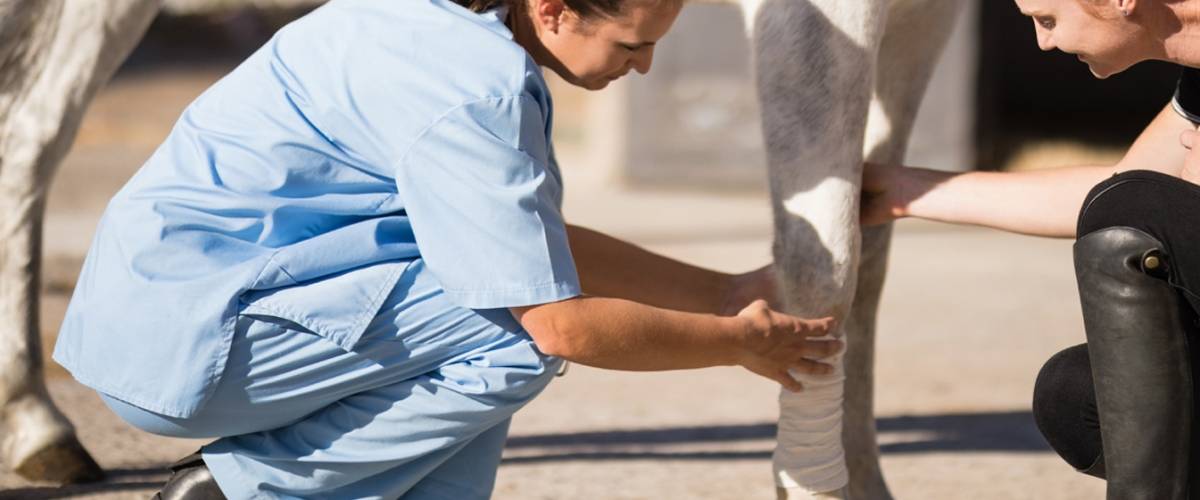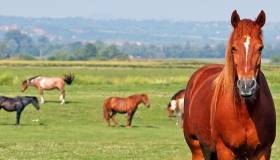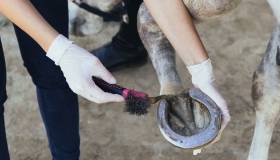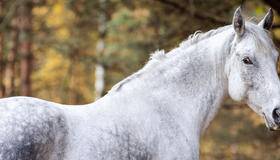
April 20, 2020 – Dr. Kelly Diehl talks with Dr. Lauren Schnabel, Associate Professor of Equine Orthopedic Surgery at North Carolina State University. The two discuss Schnabel’s new therapy to combat persistent joint infections in horses, potentially saving them from years of pain. Her team developed a platelet-rich plasma lysate that, when teamed with antibiotics, can eradicate bacterial biofilms common in joint infections.
00:10 Kelly Diehl: Welcome to Fresh Scoop, Episode 19, New Hope for Treating Joint Infections in Horses. I'm your host, Dr. Kelly Diehl, Morris Animal Foundation, Senior Director of Science and Communication. And today we'll talk to Dr. Lauren Schnabel, a Morris Animal Foundation-funded researcher, and veterinary surgeon. Dr. Schnabel is an Associate Professor of Equine Orthopedic Surgery at North Carolina State University, and a former chairperson, we miss her a lot, of our foundation's Large Animal Advisory Board. Fresh Scoop is the monthly podcast of Morris Animal Foundation, one of the largest non-profit foundations in the world dedicated to funding studies to find solutions to serious health threats in animals. And in each episode, we will feature one of our researchers we fund or one of our staff members discussing their work in advancing animal health. Whether you're a practicing veterinarian, technician or student or just an animal-loving science geek, Fresh Scoop is the podcast for you.
01:12 KD: You can learn more about us at morrisanimalfoundation.org. And so on to today's show. And again, we welcome Dr. Lauren Schnabel toady, an Associate Professor of orthopedic surgery in the Department of Clinical Sciences at North Carolina State University and a North Carolina State University faculty scholar. Lauren is a Foundation-funded researcher many times over, and her primary research interests are focused on stem cell immunology and use of regenerative therapies for the treatment of musculoskeletal injuries. Today, we'll be focusing on her Foundation-funded work on joint infections in horses. Dr. Schnabel chaired our Large Animal Advisory Board this year and is now a senior scientific advisory board member. Congratulations, Lauren. She also has a famous donkey named Henry and there are great videos of Henry. So Lauren, thanks for joining us today.
02:10 Lauren Schnabel: [chuckle] Thank you so much, Kelly. It's great to be here.
02:14 KD: So before we get into your work, tell us a little bit about yourself and your background, and how you came to veterinary medicine, and especially, equine surgery.
02:24 LS: Yes. So like many of us, I did always want to be a veterinarian from as long as I can remember. I grew up in a household with many pets in New York and was always around horses as well for fun and for riding and actually worked for a very good friend of our family as a small animal vet on Long Island and worked from him from when I was 10 years old, from everything, from cleaning kennels all the way up the ranks there. So it was actually, really not until I got into that school at Cornell, and just got on clinics that I for sure decided that I only wanted to work on horses. I just really enjoyed being in the barn and outside and around the horses more so than I did small animals just in the veterinary setting, obviously I love to have small animals and pets, but really enjoyed working on the horses from a veterinary standpoint. And I always really was fascinated by surgery, by the hands-on skills that you need and some of the immediate gratification of performing a surgery and being able to fix something or to help an animal pretty quickly in a surgical setting. So that was always very attractive to me.
03:41 KD: A lot of our people who listen are small animal clinicians and veterinary students and for those of us who are way beyond our veterinary training, that's not me of course, but some people out there might be. Can you tell us a little bit more about joint infections in horses such as, how common are they? How they arise? And why are they such a huge problem really for horses?
04:07 LS: Yeah, absolutely. And a lot of it relates to small animals as well for sure, and human. So we all are able to get joint infections which are a significant concern. Horses are particularly prone to getting joint infections because of their lifestyle, just living outside, also competing and because of the way that their legs are built, they just are... They don't have much tissue protection over the joints on their lower limbs especially, right, so there's a lot of bone and joint and not much soft tissue or muscle covering their lower limbs. So that means when they get a wound, they have a higher chance of it penetrating or going into a joint because of that. So that's the main reason that horses have a lot of problems with joint infections. But in any of the species, one of the main things my group and others are looking into is, how the bacteria actually behave within the joint fluid or synovial fluid as it's called, and that's true in all species, and human as well, is that the bacteria form these very large clusters of bacteria, so biofilms, which are a little different than even traditional biofilms the way they use the substrates in the joint fluid. And that when they're in that biofilm state, it makes them incredibly hard to treat. So traditional antibiotics can't work on those biofilms is the main thing. And that's why we were looking at new therapies to try to combat those.
05:42 KD: Right. And I was going to ask you a little bit about how traditionally these infections have been treated. And you made a good point which for folks who are listening, I think we are learning more about joint infections or we hear about them because of replacement surgery, right? So hip replacements and joint replacements, I think for people who are listening and know about infections, a big problem with them, there is some similarity I think between what you see in horses and these types of infections. So tell us a little bit about how joint infections have been treated in the past.
06:00 LS: Yeah, no, you're absolutely right. So our correlation in human medicine and the human clinicians that we work with on our research, they're treating periprosthetic joint infection, or joint infections following a replacement or some other surgical intervention into the joint. So that's exactly right. So traditionally, in horses in particular, but also in other species, we focus on flushing out the joint, or what we call lavage, which is just really trying to dilute out the bacteria. Flush them out of the joint exactly like it sounds.
06:55 LS: So high volume lavage with fluids and then sometimes we also have to debride out or take out some of the lining of the joints, where the bacteria can get trapped as well. So as you can imagine from how that sounds, that's incredibly irritating to the joint by doing those things, especially the surgical debridement, but sometimes that's necessary, or often is necessary, especially if the infection is established. And then the animals, the horses or other species, everybody is on systemic antibiotics, so usually that's intravenous and then it can sometimes switch to oral, and also local antibiotics either into the joint or with regional limb profusion. So we kind of put everything we can into treating the infection and there's a fair amount of time where that still isn't good enough.
07:51 KD: Do you have a sense of what the cure rate was for that traditional approach? How many horses would eventually completely recover or have a chronic problem?
08:04 LS: Yeah, and some of it depends on the length that the infection has been going on. So if it's an infection that we catch right away at the horses first signs of a problem, I would say it is fairly good, about maybe 80 to 90% success rate depending again on how long the infection's been going on and what the organism is that's involved. So sometimes it's a little hard to say. But where we get into trouble is if it's been going on for a while before being diagnosed, and that can happen sometimes. So let's say the horse has a wound that's open and draining into a joint, they'll stay very, very comfortable... Surprisingly comfortable. And it's actually only when that joint starts to seal and there's pressure on the joint capsule, that they get painful. So you may think, "Gosh, how could someone not notice?" But if it's open and draining some fluid, even through a tiny puncture type, they can stay very comfortable. So it can be tricky.
09:10 LS: But the problem with... So let's say 80-90% of the horses can survive this infection, the other problem is that they go on to have very sometimes debilitating arthritis in that joint, because of the damage that's occurred from the infection. So even if you're able to rid the bacteria from the joint, they can still have a lot of long-term consequences from arthritis following that. And that's another reason that we were interested in obviously improving the success rate, but also treating the horses, trying to limit that arthritis that would develop. And the main thing in horses too, is as we know, they just can't be non-weight-bearing, on one leg for a long amount of time because of laminitis, so it's essential that we make them as comfortable as possible as quickly as possible.
10:02 KD: Thanks for that explanation. Obviously you alluded to this, but why did you decide to look for a new treatment when you started to think about maybe novel ways or innovative ways of treating joint infections?
10:17 LS: Yeah, trying to improve that. So it sounds like a decent number, but I think any of us that have treated these cases clinically have had really frustrating ones where you've tried everything, you've done everything you're supposed to do and you just can't get the infection resolved. Or again, the ones that come in and unfortunately have been infected for a couple of days or a week, those are very difficult with our traditional approach to resolve. So that was very frustrating to try to lose some of those horses because of a joint infection and that's really why we wanted to do... See if there was something different that we could do. And there's been a lot of biofilm research certainly in other areas outside of the joint looking at new ways to treat biofilm infection. So that's also what got us motivated to do this.
11:11 KD: We're going to move now because this is really exciting research you did on platelet lysate. First, can you tell everyone what it is and how you're using it?
11:23 LS: Yeah, absolutely. So platelets are circulating in our blood, so the same in all species. And there's actually a common biologic that we use called platelet rich plasma for orthopedic injuries in horses, so things like tendon injuries, and also for treating arthritis in joints, and it's used in people as well. And that is very easy to make from your own... From the patient's own blood as a spin-down process in a centrifuge to concentrate platelets. And we were doing that because we know platelets are a really rich source of growth factors which help healing. But as more people have been looking at all that platelets can do, we realized a lot of researchers are looking at this now, that they contain what's called antimicrobial peptides. So peptides are proteins and anti-microbial means that they're attacking bacteria. So that platelets actually have ways to fight off infection and to kill bacteria... Novel ways. And those peptides that they have are very tiny particles and proteins that are able to get through different tissues better and able to penetrate biofilms better as we've found out.
12:43 LS: So that's a long version of that, but basically how our product differs from the PRP that we use on tendon injuries and other things is this is a really, really concentrated platelet product, and then it's sort of concentrated, and we pick out just exactly what we want. So normal PRP that we use in our orthopedic or sports medicine setting is about usually not more than three times the amount of platelets that's in whole blood. But this lysate product we use is 50 times that of whole blood. So big difference there. And then lysate is because we lyse the platelets, which makes them release everything that's inside of them, so we want to get all those good proteins out of them, and then we fractionate or separate those proteins based on their charge and their size. Like I said, the antimicrobial peptides are really small, so we're trying to pick out and only use that very small peptide so that we have a very concentrated product to use. Because even in joints, there's a limit to the volume that we can put in. Well, we want to put in the most concentrated product possible. So we spent a long time, and with the help of many collaborators and colleagues to get that version right of what we were using.
14:09 KD: That's really interesting. I want to back up for one second because when I was thinking a lot about your research, and for people listening at home, people are probably thinking, "Aren't platelets the things that help you with your blood clotting?"
14:20 LS: Yeah.
14:21 KD: And that is true. And I want to know who thought that platelets would be helpful. What was the thought process to go from blood-clotting to regenerative therapy?
14:33 LS: I know. So actually, it came out in the dental field first, platelet-rich plasma. So they were trying to figure out ways to help their implants and bone fractures or other things in the mouth or sockets for teeth to heal better. And actually, kind of came upon this. And that was the first place that platelet-rich plasma was used, trying to figure out how that works well. And then it sort of snowballed from there to figuring out, "Oh, my gosh! These platelets really can do... There are critical components." Normally, in normal health, they have all these different properties. And when people started... What's really interesting, too, is when people started using even the regular PRP, if you go back now and look at some of the studies where they were using PRP to try to help regenerate or help tissues heal after certain procedures, actually, the cases at PRP, in some instances, also had lower infection rates, which then, no one was really putting the link together until more recently to figure out exactly how many different functions the platelets have. So it's very interesting.
15:50 KD: Yeah, it's amazing when you think about these things that I think we discounted other than as something that helped your blood clot, that they're really amazing little cells.
16:04 LS: Yeah, and I think if you think about it in the context of if we had a natural wound, and platelets went there to form a clot, it does make sense that they would also do other... Since they're recruited to that site anyway, it makes sense that they'd have other things that help healing, too, if you think about all the things they'd be expected to do naturally in the body. So yeah, it's fascinating.
16:24 KD: How do you actually use this in horses? What's the process?
16:31 LS: What we've found, too, is when we're making our platelet lysate to be ready to use in horses, I'll back up one step, it actually is a much more potent product if we pool it from a bunch of different donors. So we have healthy donor horses here at NC State that we use, and they are screened to make sure they're healthy. And that way, and so, the platelet lysate we've used here has been from eight healthy donors. And if you think about that, it makes sense, too, because my platelets may have certain really good antimicrobial peptides that your platelets don't, and you probably have ones that I don't. So it's capitalizing on the best of everybody's variability, is a good way to look at it. So we found that through lots of testing, found that that was the most efficacious way to do it. So we have our pooled platelet lysate ready to go, and then we inject that with antibiotics into the horse's infected joint.
17:30 LS: So usually, in a clinical setting, the horses would still have surgery to flush out the joint, especially if it was a severe one or one that had been going on for a while. And then we follow up by injecting the lysate directly into the joint with antibiotics. And what we've seen there, and again, we're just sort of at this... We're at the start of clinical treatment. We've done a lot of background testing of the product, but we've seen a lot of amazing things. So one, obviously, being resolution of the infection, but overall, their legs are much improved, they have a normal profile, they're not nearly as swollen. Their joints are much less effusive or swollen, and the horses are comfortable a lot more quickly, so we're really excited about that.
18:18 KD: That's really amazing when you think about it. And I am really intrigued that the pooled lysate is good. And for folks listening, I think we think about blood transfusions, and there has to be certain compatibility and things like that, but that's not quite the same with platelet lysate, correct?
18:39 LS: That is absolutely correct, but that's an excellent question. So we do a lot of immunology work for stem cells, etcetera, so we're very in-tuned to that, and are very careful about what we're using from one horse to another. So yup, a couple of key things about platelet lysate. One is that it's a totally acellular product, meaning there's no cells in it because we concentrate the platelets, and then they're lysed to release what's inside of them. So you're not actually putting in cells that have surface markers on them that detect whether they're self or non-self, if that makes sense.
19:17 LS: And then you could still have things like immunoglobulin fragments, potentially, that could alert a recipient immune system of a foreign protein, but the size, since we fractionate this down to such a small size, those fragments are actually bigger than that and excluded from the product. So we're very careful that what we're using really has no reason that it should cause a potential immune response in another animal. And similarly, all our donor horses, they're screened for all of the viral diseases like the hepatitis virus, which is a huge concern now in using these biologics from one animal to another, if you're not careful about things like that also. So we're really cautious about how we're screening our donor horses and making the product for that reason, yup.
20:11 KD: Have any of your research results, I know you're using it, but do you see it being done more frequently in your clinic by other clinicians? Or is it still more experimental?
20:23 LS: Yes, great question. So it is still experimental in the sense that it's a little bit hard to make. So this is not something as easy as the traditional platelet-rich plasma used for tendon injuries like we talked about where we can just grab blood from the horse and spin it down. So this process to get the pooled platelet lysate, process it, fractionate it down to the size we want, test it to make sure it actually is antimicrobial; that takes a long time and is somewhat hard to do. So yes, we are using it in our hospital here. And I always tell clients that we've had great both in-vitro and in vivo experimental results, but that this is still a very new product to be used. And our clinicians here are certainly all onboard with it after seeing the results both in our research studies and in the horses that we've used it on so far in the hospital, because it's really been impressive. But the thing that we are working on next is trying to figure out a way that we can actually scale this product up to make it available to more people and to more veterinarians, for sure, to reach the most number of horses.
21:43 KD: And that was going to be my next question for you and your research. So you're talking about, probably, what you're going to need to do to strategize to scale up. But where are you going to go next with this product?
21:54 LS: Yeah, so that's also a great question. So two different ways we could go. One is just trying to figure out a more effective way to make this product. So right now, we're doing fractionations in the lab by hand, and it may be that there's better machines or other equipment that are able to do that more efficiently. Then a next other route to go, and we're sort of investigating both is to try to figure out, "Okay, within this product that we're using, what are the exact proteins that are having that mechanism of action?" And it's likely that it's more than one, but let's say we could identify four main ones that are responsible for this effect that we're seeing, we could actually try to synthesize those and just use those proteins, which would also be a lot more translatable to human medicine as well.
22:51 KD: As a small animal clinician, has anyone expressed interest in doing this? And for example, I think dogs, in particular, get a lot of different arthritic conditions. And osteoarthritis is a huge problem in elderly dogs and can lead to euthanasia because they're so uncomfortable. So has anyone chatted with you about that? [chuckle]
23:12 LS: Yes, yes, absolutely. No, and we're working with some of those small animal clinicians here, for sure. So one aspect is obviously the antimicrobial or the curing infections, but the product also has a lot of just chondroprotective positive effects for the joint as well, so both those avenues and absolutely, we are. And my very talented graduate student, Dr. Gilbertie, she was funded by a Morris Animal fellowship. She's been working on making this lysate from other species, including canines. So absolutely. And I think for dogs, besides arthritis, there's also, as far as ongoing infections, probably one really perfect example of a place to use it would be TPLO surgery or where you have an implant in to try to even preemptively prevent infection, help the health of the joints.
24:10 KD: So that all sounds great, Lauren. And thanks so much for joining us and telling us about this because I think it's really, really exciting and has great translational potential. And of course, it's going to help a lot, a lot, a lot of horses who suffer from this. And as you mentioned, leg problems in horses are magnified, I think, over even what people and dogs. And I'm going to look forward to reading some more of your work. So that does it for this episode of Fresh Scoop. Once again, thanks to Lauren Schnabel for joining us.
24:43 LS: Thank you!
24:43 KD: Thanks, Lauren.
24:44 LS: Thanks, Kelly.
24:46 KD: We'll be back with another episode next month that we hope you'll find just as informative. The science of animal health, as we know, is ever-changing, and veterinarians need cutting-edge research information to give their patients the best possible care, and that's why we're here. You can find us on iTunes, Spotify, Google Podcasts and Stitcher. And if you liked today's episode, we'd sure appreciate if you could take a moment to rate us since that will help others find our podcast. And of course, to learn more about Morris Animal Foundation's work, go to morrisanimalfoundation.org. There, you'll see just how we bridge science and resources to advance the health of animals. And you can also follow us on Facebook, Twitter, and Instagram. I'm Dr. Kelly Diehl, and we'll talk soon.




